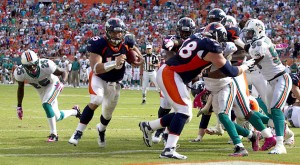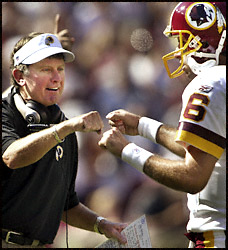Let’s get this out of the way. Bruce Arians, or an Arians/Pagano ballot, is going to win Coach of the Year. Period. But who should win it?
Coach of the Year is one of the most difficult awards to predict each year. The award often goes to the coach who most outperforms expectations rather than the coach who does the best coaching job, which is how you end up in situations where Dick Jauron and Jim Haslett were named the best coaches in 2001 and 2000, respectively.
There are no standards or guidelines to help voters determine the Coach of the Year, so every voter is left to his own devices. Today, I’m going to run down my rankings of the top 8 coaches of 2012.
8. John Fox, Denver Broncos
Having Peyton Manning makes coaching easy, but Fox still deserves credit for guiding the Broncos to an excellent season. Denver is going to finish the year on an 11-game winning streak and the Broncos are in the top five in points allowed, yards allowed, net yards per attempt allowed, rushing yards allowed, rushing touchdowns allowed, and rushing yards per carry allowed. Fox has helped turn Von Miller into one of the best two defensive players in the NFL and his hiring of Jack Del Rio to coach the defense has worked beautifully. And while Manning is having a phenomenal year, let’s not forget that it was only three months ago that people were questioning his arm strength and the Broncos were 2-3. Many coaches are doing wonderfully with less, but Fox deserves credit for helping lead Denver to the 2 seed in the AFC.
7. Gary Kubiak, Houston Texans

Gary Kubiak wishes COTY voting took place after the end of November.
It was only three weeks ago that the Texans were 11-1 and the class of the NFL. I wrote
earlier this season that Kubiak’s done an excellent job resurrecting his coaching career, and much of that remains true. He’s built this team for half a decade, and he oversaw the additions of
J.J. Watt and
Wade Phillips to the defense to complement Kubiak’s formidable offense. The Texans are likely going to earn the top seed in the A.F.C., an impressive accomplishment considering
Matt Schaub isn’t on the same tier of a
Peyton Manning or
Tom Brady. Even with a little luster off the team right now, Texans fans could hardly ask for more than home field advantage throughout the playoffs.
So why isn’t Kubiak ranked higher? I’m not sure the Texans are as good as their record and they’ve had a relatively easy schedule. Kubiak’s done an excellent job, but he also hasn’t had to face as much adversity as some other coaches this year. Houston is now one of the most talent-laden rosters in the league, and that makes Kubiak’s success just slightly less impressive.
6. Mike McCarthy, Green Bay Packers
The Packers are 11-4 — they’d have the same record as the Texans if not for the Golden Taint play — despite facing a more difficult schedule than Houston. As is seemingly an annual tradition, the Packers have placed a large number of starters on injured reserve, including right tackle Bryan Bulaga, linebackers Nick Perry, D.J. Smith, and Desmond Bishop, and Cedric Benson (along with two other running backs). Charles Woodson has only played in 7 games, James Starks and Alex Green have been banged up most of the year, and injuries have limited Greg Jennings to just 246 receiving yards this year.
Alex Green is the leading rusher with 464 yards, and he’s plodded to the tune of 3.4 yards per carry, narrowly trailing what Benson (3.5) and Starks (3.6) have produced. An anemic running game, a banged up offensive line, and injuries at receiver and tight end have resulted in Aaron Rodgers having a down season and having taken 46 sacks. Clay Matthews has missed four games and he still has 8.5 more sacks than anyone else on defense.
Yet after all that, the Packers are in line for the #2 seed in the NFC. McCarthy’s team is ranked 7th in both points and points allowed, and Green Bay has responded well in the face of adversity this season. After the painful loss to the Seahawks, would other coaches have been able to keep this team focused? After an emotional loss to the Chuckstrong Colts, you didn’t hear about grumbling in the locker room: instead, Green Bay won five straight games. Since a 38-10 shellacking against the Giants, where they looked lost, the Packers have won four in a row. If McCarthy isn’t a household name, that’s just because he’s the most underrated coach in the NFL. Despite facing numerous setbacks this season, he’s got the Packers right where everyone expected they would be.
[continue reading…]




